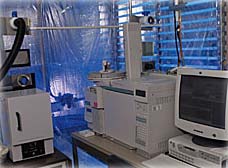Chamber reveals chemical secrets

What if there were a magical chamber that could divulge the secrets of anything that was placed inside of it? Pacific Northwest National Laboratory has developed such a chamber—and while it won’t divulge all secrets, it discloses key information about chemicals and compounds.
That information may be useful in addressing a wide range of issues that affect the environment and quality of life—everything from sick building syndrome and industrial emissions monitoring and control to sensor testing for homeland security applications.
PNNL’s chamber, known as the Atmospheric Research Chamber, was developed in 2002. The chamber concept can be traced to PNNL’s work in fate and transport studies, which revealed that there is still much to learn about how chemicals react in the environment.
The chamber actually is a large, room-sized set of dual chambers that analyzes chemical mixtures by subjecting the material to an assortment of tests. These tests, for example, characterize unknown chemical substances; expose chemicals to photo-oxidation or high humidity to mimic what might actually happen in the environment; and effectively monitor aerosols and molds. In addition, the chamber can be used to calibrate sensitive sensors or detectors for interferences like dusts, oils or other chemicals.
Teflon-lined and containing ultraviolet lights, reflective surfaces, sampling and purge ports, stirring fans and state-of- the-art analysis equipment, the chamber also provides information that could be used for determining chemical and/or biological sensor detection issues and validating computational modeling by performing actual experiments that can be done without expensive field tests. The chamber is able to measure high-boiling point, semivolatile chemicals without critical surface and line losses, shed new light on air pollution and health issues for civilian and military populations and provide improved understanding of hazardous waste discharges for more effective cleanup solutions.
“With the chamber’s unique ability to work with semi-volatile chemicals and its powerful analytical capabilities, we feel that it can serve the needs of many different clients who would not be able to find the same capabilities elsewhere,” said Kathy Probasco, senior research scientist. Probasco added the chamber’s capabilities are now available to external clients and projects.
Media Contact
More Information:
http://www.pnl.gov/news/index.htmlAll latest news from the category: Life Sciences and Chemistry
Articles and reports from the Life Sciences and chemistry area deal with applied and basic research into modern biology, chemistry and human medicine.
Valuable information can be found on a range of life sciences fields including bacteriology, biochemistry, bionics, bioinformatics, biophysics, biotechnology, genetics, geobotany, human biology, marine biology, microbiology, molecular biology, cellular biology, zoology, bioinorganic chemistry, microchemistry and environmental chemistry.
Newest articles

Silicon Carbide Innovation Alliance to drive industrial-scale semiconductor work
Known for its ability to withstand extreme environments and high voltages, silicon carbide (SiC) is a semiconducting material made up of silicon and carbon atoms arranged into crystals that is…

New SPECT/CT technique shows impressive biomarker identification
…offers increased access for prostate cancer patients. A novel SPECT/CT acquisition method can accurately detect radiopharmaceutical biodistribution in a convenient manner for prostate cancer patients, opening the door for more…

How 3D printers can give robots a soft touch
Soft skin coverings and touch sensors have emerged as a promising feature for robots that are both safer and more intuitive for human interaction, but they are expensive and difficult…





















